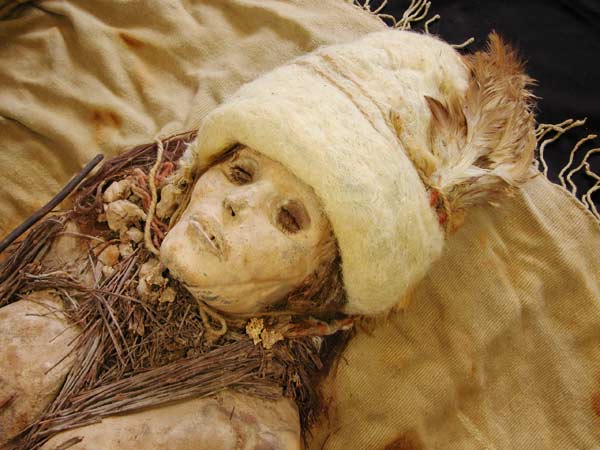Oldest cheese material identified in China
Updated: 2014-03-13 08:28
By Sun Yuanqing (China Daily)
|
||||||||
 |
|
The mummy of Princess Xiaohe in the Xiaohe cemetery. [Photo provided to China Daily] |
Yellowish clumps unearthed in ancient tombs in Northwestern China have been identified as the oldest physical evidence of cheese, researchers report in the Journal of Archaeological Science in February.
The yellowish clumps found around the neck and chest on the mummy of Princess Xiaohe in the Xiaohe cemetery in the Xinjiang Uygur autonomous region are believed to be more than 3,600 years old, making them the oldest cheese remnants known to human beings.
The project is conducted by researchers from the University of Chinese Academy of Sciences and the Max Planck Institute of Molecular Cell Biology and Genetics.
The Xiaohe site is a bronze-age burial site where more than 30 well-preserved mummies have been excavated. It was first discovered in the early 1900s and then rediscovered in 2000. The excavation of the site was credited as one of China's top 10 archaeological discoveries in 2004.
The researchers also observed that the cheese was made with a technique that is still commonly used today in making kefir, a fermented milk drink.
"We have never been able to pin down when kefir beverages or clabber were first drunk. Now we can say that it has existed for at least 3,600 years," says Yimin Yang, researcher of the project and archaeometrist from the University of Chinese Academy of Sciences.
The cheese has long provided people in the desert a sustainable source of protein without having to kill the animals. It also helps them adapt to the long travels of nomadic life, Yang adds.
Related: Chinese, German scientists discover world’s oldest cheese
 Gorgeous Liu Tao poses for COSMO magazine
Gorgeous Liu Tao poses for COSMO magazine
 Post-baby Duchess
Post-baby Duchess
 Victoria Beckham S/S 2014 presented during NYFW
Victoria Beckham S/S 2014 presented during NYFW
 'Despicable' minions upset Depp's 'Lone Ranger' at box office
'Despicable' minions upset Depp's 'Lone Ranger' at box office
 'Taken 2' grabs movie box office crown
'Taken 2' grabs movie box office crown
 Rihanna's 'Diamonds' tops UK pop chart
Rihanna's 'Diamonds' tops UK pop chart
 Fans get look at vintage Rolling Stones
Fans get look at vintage Rolling Stones
 Celebrities attend Power of Women event
Celebrities attend Power of Women event
Most Viewed
Editor's Picks

|

|

|

|

|

|
Today's Top News
NYC building collapses
China, mutinational team expand search for missing jet
Crimea declares independence
Vietnam partially suspends search
Lenovo guarantees IBM strikes
Snowden defends his NSA leaks
Hunts for fugitives to intensify
Malaysia track jet to west coast
US Weekly

|

|








